Coordination Compounds
Question 1. Write the formulas for the following coordination compounds:
- Tetraamminediaquacobalt(3) chloride
- Potassium tetracyanonickelate (2)
- Tris (ethane-1,2-diamine) chromium(3) chloride
- Ammincbromideochloridonitrito-N-platinate(2)
- Dichloridobis(ethane-1,2-diamine)platinum(4) nitrate
- Iron(3) hexacyanoferrate(2)
Answer:
⇒ \(\left[\mathrm{Co}\left(\mathrm{H}_2 \mathrm{O}\right)_2\left(\mathrm{NH}_3\right)_4\right] \mathrm{Cl}_3\)
⇒ \(\mathrm{K}_2\left[\mathrm{Ni}(\mathrm{CN})_4\right]\)
⇒ \(\left[\mathrm{Cr}(\text { en })_3\right] \mathrm{Cl}_3\)
⇒ \(\left[\mathrm{Pl}(\mathrm{NH})_3 \mathrm{BrCl}\left(\mathrm{NO}_2\right)\right]^{-}\)
⇒ \(\left[\mathrm{PtCl}_2(\mathrm{en})_2\right]\left(\mathrm{NO}_3\right)_2\)
⇒ \(\mathrm{Fe}_4\left[\mathrm{Fe}(\mathrm{CN})_6\right]_3\)
Question 2. Write the IUPAC name of the following coordination compounds:
⇒ \(\left[\mathrm{Co}\left(\mathrm{NH}_3\right)_6\right] \mathrm{Cl}_3\)
⇒ \(\left[\mathrm{Co}\left(\mathrm{NH}_3\right)_5 \mathrm{Cl}\right] \mathrm{Cl}_2\)
⇒ \(\mathrm{K}_3\left[\mathrm{Fe}(\mathrm{CN})_6\right]\)
⇒ \(\mathrm{K}_3\left[\mathrm{Fe}\left(\mathrm{C}_2 \mathrm{O}_4\right)_3\right]\)
⇒ \(\mathrm{K}_2\left[\mathrm{PdCl}_4\right]\)
⇒ \(\left[\mathrm{Pt}\left(\mathrm{NH}_3\right)_2 \mathrm{Cl}\left(\mathrm{NH}_2 \mathrm{CH}_3\right)\right] \mathrm{Cl}\)
Answer:
- Hexarmninecobalt(3) chloride
- Pentaamminechloridocobalt(3) chloride
- Potassium hexacyanoferrate(3)
- Potassium trioxalaloferrate(3)
- Potassium tetrachloridopalladate(2)
- Diamminechiorido(methylamine)platinum(2) chloride
Read and Learn More Class 12 Chemistry with Answers Chapter Wise
Question 3. Indicate the types of isomerism exhibited by the following complexes and draw the structures for these isomers:
⇒ \(\mathrm{K} \mid \mathrm{Cr}\left(\mathrm{H}_2 \mathrm{O}\right)_2\left(\mathrm{C}_2 \mathrm{O}_4\right)_2\)
⇒ \(\left[\mathrm{Co}(\mathrm{en})_3\right] \mathrm{Cl}_3\)
⇒\(\left[\mathrm{Co}\left(\mathrm{NH}_3\right)_5\left(\mathrm{NO}_2\right)\right]\left(\mathrm{NO}_3\right)_2\)
⇒ \(\left[\mathrm{Pt}\left(\mathrm{NH}_3\right)\left(\mathrm{H}_2 \mathrm{O}\right) \mathrm{Cl}_2\right]\)
Answer: 1. Both geometrical (cis-, trans-) isomers for K[Cr(H2O),(C2O4)2] can exist. Also, optical isomers for cis-isomers exist.
Geometrical isomers
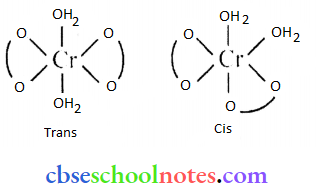
Truns-iso me r is optically inactive. On the other hand, cis-isomer is optically active.
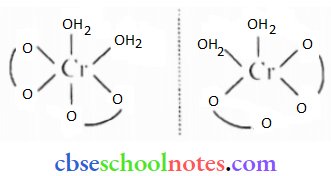
2. Two-optical isomers for [CO(en)3]Cl3 exist.

Two optical isomers arc possible Tor this structure

3. [CO(NH3)5(NO2)](NO3)2
A pair of optical isomers
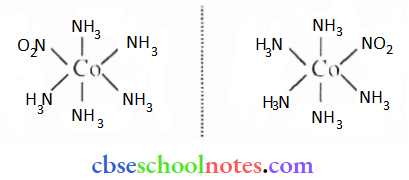
It can also show linkage isomerism [CO( NH3 )5(NO2)] ( NO3)2 and [CO(NH )5 (ONO)]( NO3)2
It can also show ionization isomerism [Co(NH3)5 (NO2)](NO3)2 and [CO(NH3)5 (NO3)] (NO3) (NO2)
Geometrical ( cis-trails-) isomers of [Pt( NH3)( H2O)Cl2] can exist.

Question 4. Give evidence that [Co(NH3)5Cl]SO4 and [Co(NH3)5SO4]CI are ionization isomers.
Answer:
When ionization isomers are dissolved in water, they ionize to give different ions, l liese ions then react differently
⇒ \(\left[\mathrm {CO} (\mathrm {NH}_{3})_{5}\mathrm {Cl} \left]\mathrm{SO}_4+\mathrm{Ba}^{2+} \longrightarrow \mathrm{BaSO}_4 \downarrow\right.\right.\) White precipitate
⇒ [CO(NH3)5Cl]SO4 + Ag+ → No reaction
⇒ [CO(NH3)5SO4]Cl + Ba2+ → No reaction
⇒ \(\left[\mathrm{CO}\left(\mathrm{NH}_3\right)_5 \mathrm{SO}_4 \mathrm]{Cl}+\mathrm{Ag}^{+} \longrightarrow \mathrm{AgCl} \downarrow\right.\)
Question 5. Explain based on valence bond theory that [Ni(CN)4]2- ion with square planar structure is diamagnetic and the [Ni(Cl4]2- ion with tetrahedral geometry Is paramagnetic.
Answer:
Ni is in the +2 oxidation state i.e., in the d8 configuration.
d8 configuration:

There are 4 CN– ions. Thus, it can either have a tetrahedral geometry or square planar geometry. Since CN– ion is a strong field ligand, it causes the pairing of unpaired 3d electrons.

It now undergoes dsp2 hybridization. Since all electrons are paired, it is diamagnetic. in. the case of [NiCl4]2-, Cl ion is a weak field ligand. Therefore, it does not lead to the pairing of impaired 3d electrons. Therefore, it undergoes sp3 hybridization.

Since there are 2 unpaired electrons in this case, it is paramagnetic.

Question 6. [NiC4]2- is paramagnetic while [NitCO)4] is diamagnetic though both are tetrahedral. Why?
Answer:
Though both [NiCl4]2- and [Ni(CO)4] are tetrahedral, their magnetic characters are different. This is due to a difference like ligands. Cl– is a weak field ligand and it does not cause the pairing of unpaired 3d electrons. Hence. [NiCl4]2- is paramagnetic.

In Ni(CO)4, Ni is in the zero oxidation state Le., it has a configuration of 3d8 4s2.

But CO is a strong field ligand. Therefore, it causes the pairing of unpaired 3d electrons. Also. it causes the 4s electrons to shift to the 3d orbital, thereby giving rise to sp3 hybridization. Since no unpaired electrons are present in this case, [Ni(CO)4] is diamagnetic.
Question 7. [Fe(H2O)6]3+ is strongly paramagnetic whereas ji’e(CN)6J’ is weakly paramagnetic. Explain.
Answer:
In both [Fe(H2O)6]3+ and [Fe(CN)6]3-, Fe exists in the +3 oxidation state i.e., in d5 configuration.

Since CN– is a strong field ligand, it causes the pairing of impaired electrons. Therefore, there is only one unpaired electron left in the d-orbital.

Therefore, \(\mu=\sqrt{n(n+2)}=\sqrt{1(1+2)}=\sqrt{3}=1.732 B M\)
On the other hand. (H2O is a weak field ligand. Therefore, it cannot cause the pairing of electrons. This means that the number of unpaired electrons is 5.
Therefore, \(\mu=\sqrt{n(n+2)}=\sqrt{5(5+2)}=\sqrt{35} \approx 6 B M\)
Thus, it is evident that [Fe(H2O)6]3+ is strongly paramagnetic, while [Fe(CN)6]3- is weakly paramagnetic.
Question 8. Explain [Co(NH3)6]3+ is an inner orbital complex whereas [Ni(NH3)6]2+ is an outer orbital complex.
Answer:
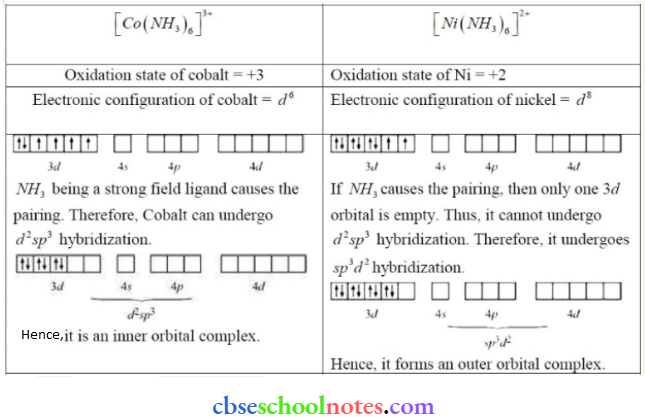
Question 9. Predict the number of unpaired electrons in the square planar [Pt(CN)6]2- ion.
Answer: [Pt(CN)6]2-
In this complex. Pt is in the +2 state. It forms a square planar structure. This means that it undergoes dsp2 hybridization. Now. the electronic configuration of Pd(+2) is 5d8.

CN– being a strong field ligand causes the pairing of unpaired electrons. Hence, there are no unpaired electrons in [Pt(CN)4]2-.
Question 10. The hexaquo manganese(ll) ion contains live unpaired electrons, while the hexacyanoion contains only one unpaired electron. Explain using Crystal Field Theory.
Answer:
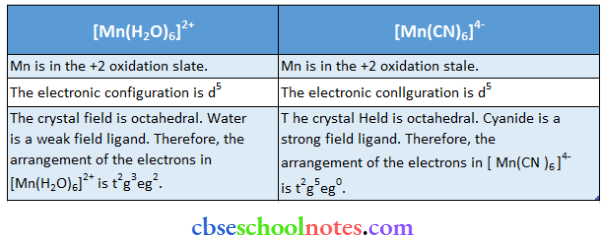
Question 11. Calculate the overall complex dissociation equilibrium constant for the Cu(NH3)2+4‘ ion. given that the β4 for this complex is 2.1 × 1013,
Answer:
⇒ \(\beta^4=2.1 \times 10^{13}\)
The overall complex dissociation equilibrium constant is the reciprocal of the overall stability constant (f.
⇒ \(\frac{1}{\beta_4}=\frac{1}{2.1 \times 10^{13}}=4.7 \times 10^{-14}\)
Question 12. Explain the bonding in coordination compounds in terms of Werner’s postulates.
Answer:
- Werner’s postulates explain the bonding in coordination compounds as follows: A metal exhibits two types of valencies namely, primary and secondary valencies. Primary valencies are satisfied by negative ions while secondary valencies are satisfied by both negative and neutral ions.
- A metal ion has a definite number of secondary valencies around the central atom. Also, these valencies project in a specific direction in the space assigned to the definite geometry of the coordination compound.
- Primary valencies are usually ionizable. while secondary valencies are non-ionizable.
Question 13. FeSO4 solution mixed with (NH4)2SO4 solutions in a 1:1 molar ratio gives the least of Fe2+ ion but CuSO4 solution mixed with aqueous ammonia in a 1:4 molar ratio does not give the least of Cu2+ ion. Explain why?
Answer:
⇒ \(\left(\mathrm{NH}_4\right)_2 \mathrm{SO}_4+\mathrm{FeSO}_4+6 \mathrm{H}_2 \mathrm{O} \longrightarrow \underset{\text { Mohr’s Salt }}{\mathrm{FeSO}_4 \cdot\left(\mathrm{NH}_4\right)_2 \mathrm{SO}_4 \cdot 6 \mathrm{H}_2 \mathrm{O}}\)
⇒ \(\mathrm{CuSO}_4+4 \mathrm{NH}_3+5 \mathrm{H}_2 \mathrm{O} \longrightarrow \underset{\text { Tetraam min copper(2)sulphate }}{\left[\mathrm{Cu}\left(\mathrm{NH}_3\right)_4\right] \mathrm{SO}_4 .5 \mathrm{H}_2 \mathrm{O}}\)
Both the compounds i.e., FeSO4. (NH4), SO4. 6H2O and [Cu(NH3)4] SO4. 5H2O falls under the category of addition compounds with only one major difference i.e., the former is an example of a double salt, while the latter is a coordination compound.
Question 14. Explain with two examples of each of the following: coordination entity, ligand, coordination number, coordination polyhedron, homoleptic and heteroleptic.
Answer:
Coordination entity: A coordination entity is an electrically charged radical or species carrying a positive or negative charge. In a coordination entity, the central atom or ion surrounded by a suitable number of neutra 1 molecules or negative ions (called ligands For example:
⇒\(\left[\mathrm{Ni}\left(\mathrm{NH}_3\right)_6\right]^{2+},\left[\mathrm{Fe}\left(\mathrm{NH}_3\right)_6\right]^{3+} \text { etc. }\) ⇒ cationic complex
⇒ \(\left[\mathrm{PtCl}_4\right]^{2-},\left[\mathrm{Ag}(\mathrm{CN})_2\right]^{-} \quad \text { etc. }\) ⇒ anionic complex
⇒ \(\left[\mathrm{Ni}(\mathrm{CO})_4\right] \cdot\left[\mathrm{Co}\left(\mathrm{NH}_3\right)_4 \mathrm{Cl}_2\right] \text { etc. }\) ⇒ neutral complex
Ligands: The neutral molecules or negatively charged ions that surround the metal atom in a coordination entity or a coordinate complex are known as ligands. For example Cl, FLO. H, N CFLCFLNFL etc.
Coordination number: The total number of ligands (either neutral molecules or negative ions) that get attached to the central metal atom in the coordination sphere is called the coordination number of the central metal atom. It is also referred to as its legacy.
For example:
- In the complex, K2[PtCI]6 there as six chloride ions attached to Pt in the coordinate sphere. Therefore, the coordination number of Pt is 6.
- Similarly, in the complex [Ni(NH3)4 ]Cl2, the coordination number of the central atom (Ni) is 4.
Coordination polyhedron: Coordination polyhedrons about the central atom can be
defined as the spatial arrangement of the ligands that are directly attached to the central metal ion in the coordination sphere. For example:
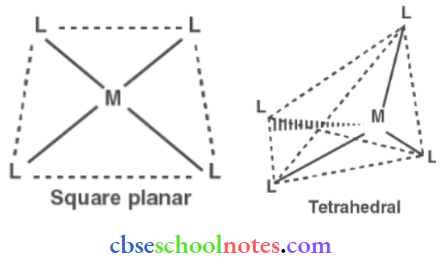
Homoleptic complexes: These are those complexes in which the metal ion is bound to only one kind of a donor group.
For example., [Co(NH3)6]3+ .[PtCl4]2- etc.
Heteroleptic complexes: Heteroleptic complexes are those complexes where the central metal ion is bound to more than one type of donor group.
For example., [Co(NH3)4 Cl2]+ ,[Co(NH3)5Cl]2+
Question 16. What is meant by unidentate? dentate and ambidentate ligands? Give two examples for each.
Answer:
A ligand may contain one or more unshared pail’s of electrons which are called the donor sites of ligands. Now. depending on the number of these donor sites, ligands can be classified as follows:
Unidenatate ligands: Ligands with only one donor site arc are called unidentate ligands.
⇒ \(\ddot{\mathrm{N}} \mathrm{H}_3, \mathrm{Cl}^{-2} \text { etc. }\)
Didentate ligands: Ligands that have two donor sites arc called bidentate ligands. For example.,
Ethane- 1, 2-diamine

Ambidentate ligands: Ligands that can attach themselves to the central metal atom through two different atoms are called ambidentate ligands. For example:

Question 17. Specify the oxidation numbers of the metals in the following coordination entities:
- \(\left[\mathrm{Co}\left(\mathrm{H}_2 \mathrm{O}\right)(\mathrm{CN})(\mathrm{en})_2\right]^{2+}\)
- \(\left[\mathrm{CoBr}_2(\mathrm{en})_2\right]^{+}\)
- \(\left[\mathrm{PtCl}_4\right]^{2-}\)
- \(\mathrm{K}_3\left[\mathrm{Fe}(\mathrm{CN})_6\right]\)
- \(\left[\mathrm{Cr}\left(\mathrm{NH}_3\right)_3 \mathrm{Cl}_3\right]\)
Answer:
1. \(\left[\mathrm{Co}\left(\mathrm{H}_2 \mathrm{O}\right)(\mathrm{CN})(\mathrm{en})_2\right]^{2+}\)
Let the oxidation number of Co be x.
The charge on the complex is +2

x- 1 = +2
x = +3
2. [PtCl4]–
Let the oxidation number of Pt be x.
The charge on the complex is -2,
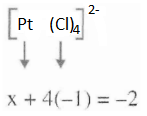
x = +2
3. 
x- 2= +1
x =+3
4. \(\mathrm{K}_3\left[\mathrm{Fe}(\mathrm{CN})_6\right]\)
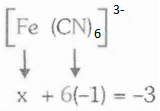
x – 2 = +1
x = +3
5. K3[Fe(CN)6]
x = +3

x – 3 = 0
x = +3
Question 18. Using IUPAC norms write the formulas for the following:
- Tetrahydroxozincatc (2)
- Potassium tetrachloridopalladate (2)
- Diamminedichloridoplatinum (2)
- Potassium tetracyanonickelate (2)
- Pentaamminenitrito-O-cobalt (3)
- Hexaamminecobalt (3) sulphate
- Potassium tri(oxalate)chromate (3)
- Hexaammineplatinum (4)
- Tetrabromidocuprate (2)
- Pentaamminenitrito-N-cobalt (3)
Answer:
- \(\left[\mathrm{Zn}(\mathrm{OH})_4\right]^{2-}\)
- \(\mathrm{K}_2\left[\mathrm{PdCl}_4\right]\)
- \(\left[\mathrm{Pt}\left(\mathrm{NH}_3\right)_2 \mathrm{Cl}_2\right]\)
- \(\mathrm{K}_2\left[\mathrm{Ni}(\mathrm{CN})_4\right]\)
- \(\left[\mathrm{Co}(\mathrm{ONO})\left(\mathrm{NH}_3\right)_5\right]^{2+}\)
- \(\left[\mathrm{Co}\left(\mathrm{NH}_3\right)_6\right]_2\left(\mathrm{SO}_4\right)_3\)
- \(\mathrm{K}_3\left[\mathrm{Cr}\left(\mathrm{C}_2 \mathrm{O}_4\right)_3\right]\)
- \(\left[\mathrm{Pt}\left(\mathrm{NH}_3\right)_6\right]^{4+}\)
- \(\left[\mathrm{Cu}(\mathrm{Br})_4\right]{^2-}\)
- \(\left[\mathrm{Co}\left[\mathrm{NO}_2\right)\left(\mathrm{NH}_3\right)_5\right]^{2+}\)
Question 19. Using IUPAC norms write the systematic names of the following:
- \(\left[\mathrm{Co}\left(\mathrm{NH}_3\right)_6\right] \mathrm{Cl}_3\)
- \(\left[\mathrm{Pt}\left(\mathrm{NH}_3\right)_2 \mathrm{Cl}\left(\mathrm{NH}_2 \mathrm{CH}_3\right)\right] \mathrm{Cl}\)
- \(\left[\mathrm{Ti}\left(\mathrm{H}_2 \mathrm{O}\right)_6\right]^{3+}\)
- \(\left[\mathrm{Co}\left(\mathrm{NH}_3\right)_4 \mathrm{Cl}\left(\mathrm{NO}_2\right)\right] \mathrm{Cl}\)
- \(\left[\mathrm{Mn}\left(\mathrm{H}_2 \mathrm{O}\right)_6\right]^{2+}\)
- \(\left[\mathrm{NiCl}_4\right]^{2-}\)
- \(\left[\mathrm{Ni}\left(\mathrm{NH}_3\right)_6\right] \mathrm{Cl}_2\)
- \(\left[\mathrm{Co}(\mathrm{en})_3\right]^{3+}\)
- \(\left[\mathrm{Ni}(\mathrm{CO})_4\right]\)
Answer:
- Hexaamminecobalt (3) chloride
- Diamminechlorido (methylamine) platinum (2) chloride
- Hexaaquatitanium (3) ion
- Tetraamminechloridonitrito-N-Cobalt (3) chloride
- Hexaaquamangancse (2) ion
- Tetrachloridonickelate (2) ion
- Hexaamminenickcl (2) chloride
- Tris (ethane- 1, 2-diamine) cobalt (3) ion
- Tetracarbonylnickel (0)
Question 20. List various types of isomerism possible for coordination compounds, giving an example of each.
Answer:
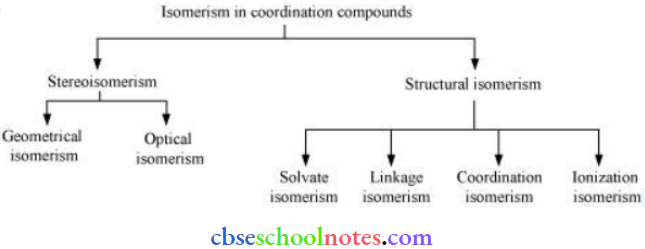
1. Geometrical Isomerism: This type of isomerism is common in heteroleptic complexes. It arises due to the different possible geometric arrangements of the ligands. For example:
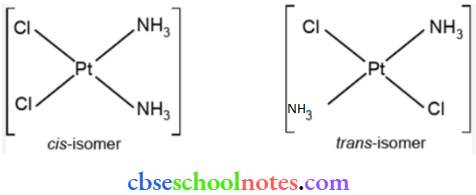
2. Optical Isomerism: This type of isomerism arises in chiral molecules. Isomers are mirror images of each other and are non-superim possible.
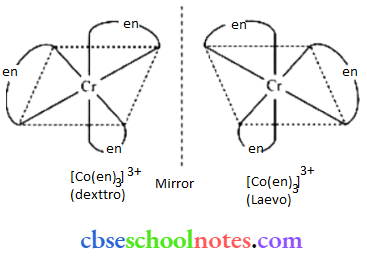
3. Linkage Isomerism: This type of isomerism is found in complexes that contain ambidentate ligands.
![]()
4. Coordination Isomerism: This type of isomerism arises when the ligands are interchanged between cationic and anionic entities of different metal ions present in the complex.
For example \(\left[\mathrm{Co}\left(\mathrm{NH}_3\right)_6\right]\left[\mathrm{Cr}(\mathrm{CN})_6\right] \text { and }\left[\mathrm{Cr}\left(\mathrm{NH}_3\right)_6\right]\left[\mathrm{Co}(\mathrm{CN})_6\right]\)
5. Ionization Isomerism: This type of isomerism arises when a counter ion replaces a ligand within the coordination sphere. For example
⇒ \(\left[\mathrm{Co}\left(\mathrm{NH}_3\right)_5 \mathrm{SO}_4\right] \mathrm{Br} \text { and }\left[\mathrm{Co}\left(\mathrm{NH}_3\right)_5 \mathrm{Br}\right] \mathrm{SO}_4\)
6. Solvate Isomerism: Solvate isomers differ by whether or not the solvent molecule is directly bonded to the metal ion or merely present as a free solvent molecule in the crystal lattice.

Question 21. How many geometrical isomers are possible in the following coordination entities?
- [Cr(C2O4)3]3+
- [Co(NH3)3Cl3]
Answer:
For [Cr(C2O4)3]3+ no geometrical isomer is possible as it is a bidentate ligand.

[Co(NH3)3Cl3] Two geometrical isomers are possible.
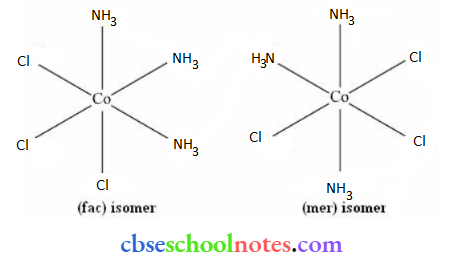
Question 22. Draw the structure of optical isomers of:
- \(\left[\mathrm{Cr}\left(\mathrm{C}_2 \mathrm{O}_4\right)_3\right]^{3-}\)
- \(\left[\mathrm{PtCl}_2(\mathrm{en})_2\right]^{2+}\)
- \(\left[\mathrm{Cr}\left(\mathrm{NH}_3\right)_2 \mathrm{Cl}_2(\mathrm{en})\right]^{+}\)
Answer: 1. \(\left[\mathrm{Cr}\left(\mathrm{C}_2 \mathrm{O}_4\right)_3\right]^{3-}\)
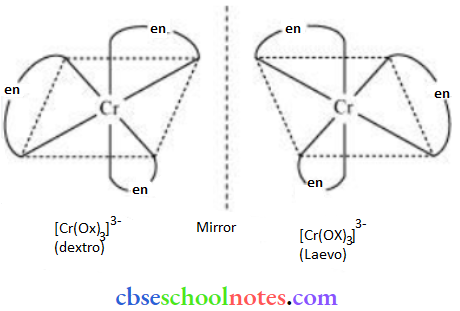
2. \(\left[\mathrm{PtCl}_2(\mathrm{en})_2\right]^{2+}\)
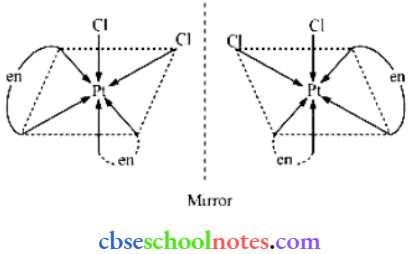
3. \(\left[\mathrm{Cr}\left(\mathrm{NH}_3\right)_2 \mathrm{Cl}_2(\mathrm{en})\right]^{+}\)
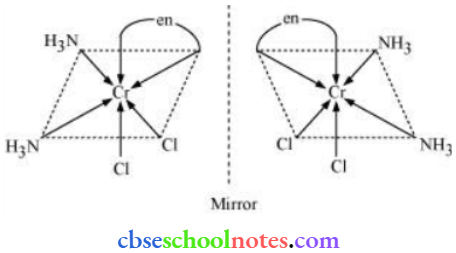
Question 23. Draw all the isomers (geometrical and optical) of:
- \(\left[\mathrm{CoCl}_2(\mathrm{en})_2\right]^{+}\)
- \(\left[\mathrm{Co}\left(\mathrm{NH}_3\right) \mathrm{Cl}(\mathrm{en})_2\right]^{2+}\)
- \(\left[\mathrm{Co}\left(\mathrm{NH}_3\right)_2 \mathrm{Cl}_2(\mathrm{en})\right]^{+}\)
Answer: 1. \(\left[\mathrm{CoCl}_2(\mathrm{en})_2\right]^{+}\)

In total, three isomers are possible.
2. \(\left[\mathrm{Co}\left(\mathrm{NH}_3\right) \mathrm{Cl}(\mathrm{en})_2\right]^{2+}\)
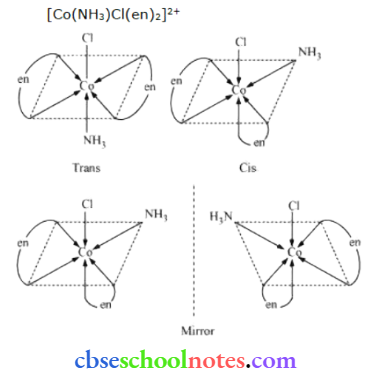
Trans-isomers are optically inactive.
Cis-isomers are optically active.
3. \(\left[\mathrm{CoCl}_2(\mathrm{en})_2\right]^{+}\)
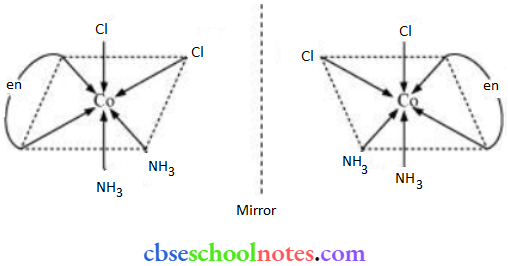
Question 24. Write all the geometrical isomers of [Pt(NH3)(Br)(G)(py)j and how many of these will exhibit optical isomers?
Answer: [Pt(NH3)(Br)(Cl)(py)]

From the above prisoners, none will exhibit optical isomers. Tetrahedral complexes rarely show optical isomerization. They do so only in the presence of unsymmetrical chelating agents.
Question 25. Aqueous copper sulphate solution (blue) gives:
- A green precipitate with aqueous potassium fluoride, and
- A bright green solution with aqueous potassium chloride Explain these experimental results.
Answer:
Aqueous CuSO4 exists as [Cu(H2O)4]SO4 It is blue due to the presence of [Cu(H2O)4]2+ ions.
When KF is added.
![]()
When KCI is added:
⇒ \(\left[\mathrm{Cu}\left(\mathrm{H}_2 \mathrm{O}_4\right)\right]^{2+}+4 \mathrm{Cl}^{-} \longrightarrow \underset{\text { (bright green) }}{\left[\mathrm{CuCl}_4\right]^{2-}}+4 \mathrm{H}_2 \mathrm{O}\)
In both these cases, the weak field ligand water is replaced by the F and Cl ions.
Question 26. What is the coordination entity formed when an excess of aqueous KCN is added to an aqueous solution of copper sulphate? Why is it that no precipitate of copper sulphide is obtained when H2S (g) is passed through this solution?
Answer:
⇒ \(\mathrm{CuSO}_{4(\mathrm{aq})}+4 \mathrm{KCN}_{(\mathrm{aq})} \longrightarrow \mathrm{K}_2\left[\mathrm{Cu}(\mathrm{CN})_4\right]_{(\mathrm{aq})}+\mathrm{K}_2 \mathrm{SO}_{4(\mathrm{aq})}\)
⇒ \(\left[\mathrm{Cu}\left(\mathrm{H}_2 \mathrm{O}\right)_4\right]^{2+}+4 \mathrm{CN}^{-} \longrightarrow\left[\mathrm{Cu}(\mathrm{CN})_4\right]^{2-}+4 \mathrm{H}_2 \mathrm{O}\)
Thus, the coordination entity formed in the process is K2[Cu(CN)4]. It is a very stable complex, which does not ionize to give Cu2+ ions when added to water. Hence, Cu2+ ions are not precipitated when H2S, i is passed through the solution.
Question 27. Discuss the nature of bonding in the following coordination entities based on valence bond theory:
- [Fe(CN)6]4-
- [FeF6]3-
- [Co(C2CO4)3]3-
- [CoF6]3-
Answer: [Fe(CN)6]4-
In the above coordination complex, iron exists in the +2 oxidation state.
Fe2+: Electronic configuration is 3d6
Orbitals of Fe2+ ion:

As CN– ion is a strong field ligand, it causes the pairing of the unpaired 3d electrons.

Since there are six ligands around the central metal ion, the most feasible hybridization is d2sp3.
d2sp3 hybridized orbitals of Fe2+ are:

6 electron pairs from CN– ions occupy the six hybrid dfsp3 orbitals.
Then,

Hence, the geometry of the complex is octahedral and the complex is diamagnetic (as there are no unpaired electrons).
2. [FeF6]3-
In this complex, the oxidation state of Fe is +3.
Orbitals of Fe-3 ion:

There are 6 F– ions. Thus, it will undergo d2sp3 or sp2d3 hybridization. As F– is a weak field ligand, it does not cause the pairing of the electrons in the 3d orbitals. Hence, the most feasible hybridization is sp3d2.
sp3d2 hybridized orbitals of Fe3+ it are:
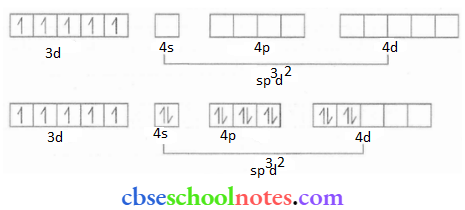
Hence, the geometry of the complex is found to be octahedral.
3. [Co(C2CO4)3]3-
Cobalt exists in the +3 oxidation state in the given complex.
Orbitals of Co3+ ion:

Oxalate ion is a weak field ligand. Therefore, it cannot cause the pairing of the 3d orbital electrons. As there are 6 ligands, hybridization has to be sp3d2.
sp3d2 hybridized orbitals of Co3+

The 6 electron pairs from the 3 oxalate ions (oxalate anion is a bidentate ligand) occupy these sp3d2 orbitals.

Hence, the geometry of the complex is found to be octahedral.
4. [CoF2]3-
Cobalt exists in the +3 oxidation state.
Orbitals of Co3+ ion:

Again, fluoride ion is a weak field ligand. It cannot cause the pairing of the 3d electrons. As a result, the Co!+ ion will undergo sp’d2 hybridization. sp3d2 hybridized orbitals of Co3+ ion are:
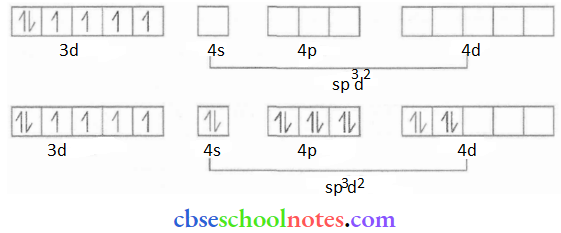
Hence, the geometry of the complex is octahedral and paramagnetic.
Question 28. Draw a figure to show the splitting of d orbitals in an octahedral crystal field.
Answer:
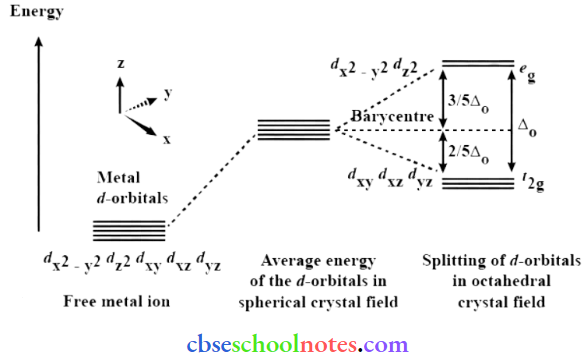
Question 29. What is a spectrochemical series? Explain the difference between a weak field and a strong field ligand.
Answer:
A spectrochemical series is the arrangement of common ligands in the increasing order of their crystal-field splitting energy (CFSE) values. The ligands present on the R.H.S of the series are strong field ligands while that on the L.H.S are weak field ligands. Also, strong field ligands cause higher splitting in the d orbitals than weak field ligands.
I-< Br- <S2 <SCN <CI <N3- <OH– <C2O 2-4 <~H2O < NCS– <edta4- <NH3<en– <CN– < CO
Question 30. What is crystal field splitting energy? How does the magnitude of Δ0 decide the actual configuration of d-orbitals in a coordination entity?
Answer:
- The degenerate d-orbitals (in a spherical field environment) split into two levels i.e., eg and t2g in the presence of ligands. The splitting of the degenerate levels due to the presence of ligands is called crystal-field splitting while the energy difference between the two levels (eg and t2g) is called the crystal-field splitting energy.
- It is denoted by Δ0. After the orbitals have split, the filling of the electrons takes place. After 1 electron (each) has been filled in the three t2g orbitals, the filling of the fourth electron takes place in two ways.
- It can enter the e orbitals (giving rise to t32g e1g like electron configuration) or the pairing of the electrons can take place in the t2g orbitals (giving rise to t42g e0g like electronic configuration).
- If the A0 value of a ligand is less than the pairing energy (P), then the electrons enter the e orbital. On the other hand, if the Δ0 value of a ligand is more than the pairing energy (P), then the electrons enter the t2g orbital.
Question 31. [Cr(NH3)6]3+ is paramagnetic while [Ni(CN)4]2- is diamagnetic. Explain why?
Answer:
In [Cr(NH3)6]3+ Cr is in the +3 oxidation state i.e., d3 configuration. Since there are three unpaired electrons in 3d orbitals.

Therefore, it undergoes d2sp3 hybridization and the electrons in the 3d orbitals remain unpaired. Hence, it is paramagnetic.
In [Ni(CN)4]2- Ni exists in the +2 oxidation state i.e., d8 configuration.

CN– is a strong field ligand. It causes the pairing of the 3d orbital electrons. Then, Ni2+ undergoes dsp2 hybridization.

As there are no unpaired electrons, it is diamagnetic.
Question 32. A solution of [Ni(H2O)6]2+ is green but a solution of [Ni(CN)4]2- is colourless. Explain.
Answer:
- In [Ni(H2O)6]2+, H2O is a weak field ligand. Therefore, there are unpaired electrons in Ni-‘. In this complex, the 3d electrons from the lower energy level can be excited to the higher energy level i.e., the possibility of d-d transition is present.
- Hence,[Ni(H2O)6]2+ is coloured. In [Ni(CN)4]2- the electrons are all paired as CN is a strong field ligand. Therefore, d-d transition is not possible in [Ni(CN)4]2-. Hence, it is colourless.
Question 33. [Fe(CN)6]4- and [Fe(H2O)6]2+ are of different colours in dilute solutions. Why?
Answer:
- The colour of a particular coordination compound depends on the magnitude of the crystal-field splitting energy, Δ. This CFSE in turn depends on the nature of the ligand.
- In the case of [Fe(CN)6]4- and [Fe(H2O)6]2+, the colour differs because there is a difference in the CFSE. Now CN– is a strong field ligand having a higher CFSE value of compound to the CFSE value of water. This means that the absorption of energy for the infra d-d transition also differs. Hence the transmitted colour also differs.
Question 34. Discuss the nature of bonding in metal carbonyls.
Answer:
- The metal-carbon bonds in metal carbonyls have both σ and π characters. An σ bond is formed when the carbonyl carbon donates a lone pair of electrons to the vacant orbital of the metal.
- A π bond is formed by the donation of a pair of electrons from the filled metal d orbital into the valent anti-bonding π* orbital (also known as back bonding of the carbonyl group).
- The σ bond strengthens the π bond and vice versa. Thus, a synergic effect is created due to this metal-ligand bonding. This synergic effect strengthens the bond between CO and the metal.
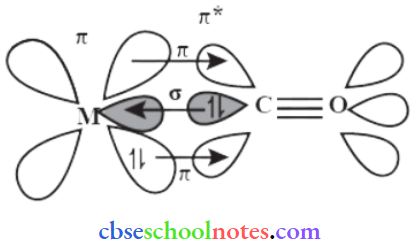
Question 35. Give the oxidation state, d-orbital occupation and coordination number of the central metal ion in the following complexes:
Answer:
- \(\mathrm{K}_3\left[\mathrm{Co}\left(\mathrm{C}_2 \mathrm{O}_4\right)_3\right]\)
- \(\text { cis- }\left[\mathrm{Cr}(\mathrm{en})_2 \mathrm{Cl}_2\right] \mathrm{Cl}\)
- \(\left(\mathrm{NH}_4\right)_2\left[\mathrm{CoF}_4\right]\)
- \(\left[\mathrm{Mn}\left(\mathrm{H}_2 \mathrm{O}\right)_6\right] \mathrm{SO}_4\)
Answer:
1. \(\mathrm{K}_3\left[\mathrm{Co}\left(\mathrm{C}_2 \mathrm{O}_4\right)_3\right]\)
The central metal ion is Co3+
Its coordination number is 6.
The oxidation state can be given as:
x – 6 = -3
x = +3
The d orbitals occupation for Co3+ is t62g e0g.
2. \(\text { cis- }\left[\mathrm{Cr}(\mathrm{en})_2 \mathrm{Cl}_2\right] \mathrm{Cl}\)
The central metal ion is Cr3+
The coordination number is 6.
The oxidation state can be given as:
x + 2(0) + 2(-1) = +1
x- 2 = +1
x = +3
The d orbitals occupation for Cr3+ is t32g.
3. \(\left(\mathrm{NH}_4\right)_2\left[\mathrm{CoF}_4\right]\)
The central metal ion is Co2+.
The coordination number is 4.
The oxidation state can be given as:
x- 4 = -2
x = +2
The d orbitals occupation for Co2+ is e 4g t32g
4. \(\left[\mathrm{Mn}\left(\mathrm{H}_2 \mathrm{O}\right)_6\right] \mathrm{SO}_4\)
The central metal ion is Mn2+.
The coordination number is 6.
The oxidation state can be given as:
x + 0 = +2
x = +2
The d orbitals occupation for Mn2+ is t32g e2g.
Question 36. Write down the IUPAC name for each of the following complexes and indicate the oxidation state, electronic configuration and coordination number. Also, give the stereochemistry and magnetic moment of the complex:
- \(\mathrm{K}\left[\mathrm{Cr}\left(\mathrm{H}_2 \mathrm{O}\right)_2\left(\mathrm{C}_2 \mathrm{O}_4\right)_2\right] \cdot 3 \mathrm{H}_2 \mathrm{O}\)
- \(\left[\mathrm{Co}\left(\mathrm{NH}_3\right)_5 \mathrm{Cl}\right] \mathrm{Cl}_2\)
- \(\mathrm{CrCl}_3(\mathrm{py})_3\)
- \(\mathrm{Cs}\left[\mathrm{FeCl}_4\right]\)
- \(\mathrm{K}_4\left[\mathrm{Mn}(\mathrm{CN})_6\right]\)
Answer:
1. \(\mathrm{K}\left[\mathrm{Cr}\left(\mathrm{H}_2 \mathrm{O}\right)_2\left(\mathrm{C}_2 \mathrm{O}_4\right)_2\right] \cdot 3 \mathrm{H}_2 \mathrm{O}\)
IUPAC Name: Potassium diaquadioxalatochromate (TIT) trihydrate.
The oxidation state of chromium = +3
Electronic configuration: 3d3: t32g
Coordination number = 6
Shape: octahedral
Stereochemistry:


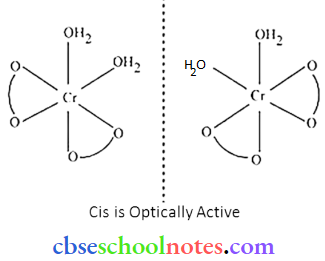
Magnetic moment, \(\mu=\sqrt{n(n+2)}\)
\(\mu=\sqrt{3(3+2)}=\sqrt{5} \sim 4 \mathrm{BM}\)2. \(\left[\mathrm{Co}\left(\mathrm{NH}_3\right)_5 \mathrm{Cl}\right] \mathrm{Cl}_2\)
TUPAC name: Pcntaamminechloridocoball (3) chloride
The oxidation state of Co = +3
Coordination number = 6
Shape: octahedral.
Electronic configuration : d6: t62g.
Stereochemistry:
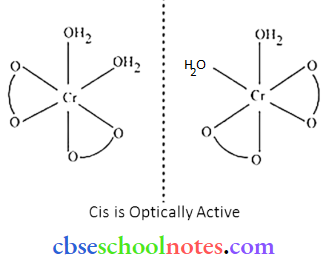
Magnetic Moment = 0
3. CrCl3(py)3
TUPAC name: Trichloridotripyridincchromiuixi (3)
The oxidation state of chromium = +3
Electronic configuration for d3: t32g
Coordination number = 6
Shape: octahedral.
Stereochemistry:

Both isomers are optically active. Therefore, a total of 4 isomers exist.
Magnetic moment, \(\mu=\sqrt{n(n+2)}=\sqrt{3(3+2)}=\sqrt{15} \sim 4 B M\)
4. Cs[FeCl4]
IUPAC name: Caesium tetrachloroferrate (3)
The oxidation state of Fe = +3
Electronic configuration d5: e2g t32g
Coordination number = 4
Shape: tetrahedral
Stereochemistry: optically inactive
Magnetic moment:
⇒ \(\mu=\sqrt{\mathrm{n}(\mathrm{n}+2)}=\sqrt{5(5+2)}=\sqrt{35} \sim 6 \mathrm{BM}\)
5. K4[Mn(CN)6]
IUPAC Name: Potassium hexacyanomanganate (2)
The oxidation state of manganese = +2
Electronic configuration: d5: t52g
Coordination number = 6
Shape: octahedral
S(geochemistry:optically inactive
Magnetic moment,
⇒ \(\mu=\sqrt{\mathrm{n}(\mathrm{n}+2)}=\sqrt{1(1+2)}=\sqrt{3}=1.732 \mathrm{BM}\)
Question 37. What is meant by the stability of a coordination compound in solution? State the factors which govern the stability of complexes.
Answer:
The stability of a complex in a solution refers to the degree of association between the two species involved in a state of equilibrium. Stability can be expressed quantitatively in terms of stability constant or formation constant.
⇒ \(\mathrm{M}+3 \mathrm{~L} \rightleftharpoons \mathrm{ML}_3\)
Stability constant,
⇒ \(\beta=\frac{\left[\mathrm{ML}_3\right]}{[\mathrm{M}][\mathrm{L}]^3}\)
For this reaction, the greater the value of the stability constant, the greater is the proportion of ML3 in the solution.
Stability can be of two types:
- Thermodynamic stability: The extent to which the complex will be formed or will be transformed into another species at the point of equilibrium is determined by thermodynamic stability.
- Kinetic stability: This helps determine the speed with which the transformation will occur to attain the state of equilibrium.
Question 38. What is meant by the chelate effect? Give an example.
Answer:
When a ligand attaches to the metal ion in a manner that forms a ring, then the metal-ligand association is found to be more stable. In other words, we can say that complexes containing chelate rings are more stable than complexes without rings. This is known as the chelate effect.
For example: ⇒ \(\mathrm{Ni}_{(\mathrm{aq})}^{2+}+6 \mathrm{NH}_{3 \mathrm({aq})} \longleftrightarrow\left[\mathrm{Ni}\left(\mathrm{NH}_3\right)_6\right]_{(\mathrm{aq})}^{2+} \log \beta=7.99\)
⇒ \(\mathrm{Ni}_{(\mathrm{aq})}^{2+}+3 \mathrm{en}_{(\mathrm{aq})} \longleftrightarrow\left[\mathrm{Ni}(\mathrm{en})_3\right]_{(\mathrm{aq})}^{2+} \log \beta=18.1 \text { (more stable) }\)
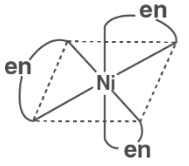
Question 39. Discuss briefly giving an example in each case the role of coordination compounds in:
- Biological system
- Medicinal chemistry
- Analytical Chemistry
- Extraction/metallurgy of metals
Answer:
- Role of coordination compounds in biological system: We know that photosynthesis is made possible by the presence of the chlorophyll pigment. This pigment is a coordination compound of magnesium.
- Role of coordination compounds in medicinal chemistry: Certain coordination compounds of platinum (for example, cis-plutin) are used for inhibiting the growth of tumours.
- Role of coordination compounds in analytical chemistry: During salt analysis, several basic radicals are detected with the help of the colour changes they exhibit with different reagents.
- Role of coordination compounds in extraction or metallurgy of metals: From [Au(CN)2]+ solution, gold is extracted by the addition of zinc metal.
Question 40. How many ions are produced from the complex Co(NH3)6Cl2 in solution?
- 6
- 4
- 3
- 2
Answer: 3
The given complex can be written as Co(NH3)6Cl2 Thus, [Co(NH3)6]2+ along with two Cl ions are produced.
Question 41. Amongst the following ions which one has the highest magnetic moment value?
- [Cr(H2O6)]3+
- [Fe(H2O)6]2+
- [Zn(H2O)6]2+
Answer:
No. of unpaired electrons in [Cr(H2O6)]3+ = 3
⇒ \(\mu=\sqrt{n(n+2)}=\sqrt{3(3+2)}=\sqrt 15 {\sim 4 B M}\)
No. of unpaired electrons in [Fe(H2O)6]2+ = 4
⇒ \(\mu=\sqrt{4(4+2)}=\sqrt{24} \sim 5 \mathrm{BM}\)
No. of unpaired electrons in [Zn(H2O)6]2+ = 0
Hence, [Fe(H2O)6]2+ has the highest magnetic moment value.
Question 42. The oxidation number of cobalt in K[Co(CO)4] is
- +1
- +3
- -1
- -3
Answer:
We know that CO is a neutral ligand and K carries a charge of + 1. Therefore, the complex can be written as K+[Co(CO)4]–. Therefore, the oxidation number of Co in the given complex is -1. Hence, option (3) is correct.
Question 43. Amongst the following, the most stable complex is
- [Fe(H2O)6]3+
- [Fe(NH3)6]3+
- [Fe(C2O4)3]3-
- [FeCl6]3-
Answer:
We know that the stability of a complex increases by chelation. Therefore, the most stable complex is [Fe(C2O4)3]3-

Question 44. What will be the correct order for the wavelengths of absorption in the visible region for the following:
⇒\(\left[\mathrm{Ni}\left(\mathrm{NO}_2\right)_6\right]^{4-},\left[\mathrm{Ni}\left(\mathrm{NH}_3\right)_6\right]^{2+},\left[\mathrm{Ni}\left(\mathrm{H}_2 \mathrm{O}\right)_6\right]^{2+}\)
Answer:
The central metal ion in all three complexes is the same. Therefore, absorption in the visible region depends on the ligands. The order in which the CFSE value of the ligands increases in the spectrochemical series is as follows:
H2O < NH3 < NO2–
Thus, the amount of crystal-field splitting observed will be in the following order:
Δ0[H2O] < Δ0[NH3] < Δ0[NO2-]
Hence, the wavelengths of absorption in the visible region will be in the following order:
⇒ \(\left[\mathrm{Ni}\left(\mathrm{H}_2 \mathrm{O}\right)_6\right]^{2+}>\left[\mathrm{Ni}\left(\mathrm{NH}_3\right)_6\right]^{2+}>\left[\mathrm{Ni}(\mathrm{NO})_6\right]^{4-}\)
